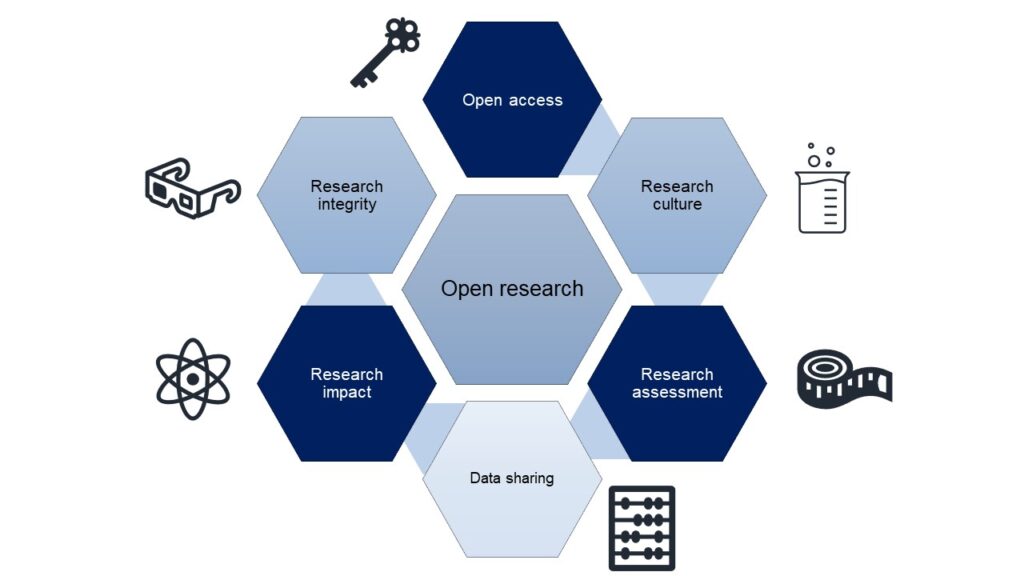The recent growth in open access publishing has morphed into a broader discussion concerning the nature of the research life cycle. These broader – open research – considerations refer to aspects of research integrity, reproducibility, data access, data sharing and peer review that have wide-reaching implications for those conducting and communicating research.
A changing academic landscape
Open research principles have already had a significant impact on the scientific landscape, influencing both the way that established researchers are conducting their work and the way that early career researchers are being trained.
Author interest in open access publishing has led to year-on-year growth in the number of publications made freely available to readers,1 complemented by significant growth in the number of fully OA journal venues.2 Within academia, post graduate programmes around the world are now delivering open research modules, and research assessment reforms around the globe are increasingly looking to include open research assessment criteria.

(Figure produced by Taylor & Francis)
Implications for the pharma research
Widespread implementation of open research principles across universities and academic research centres represents a fundamental culture shift in the way that basic science has traditionally been conducted. As a cohort, early career researchers versed in methodologies designed to promote and encourage greater transparency, data reproducibility and data sharing are likely to bring these values to bear on research questions encountered throughout their careers. Thus, these aspiring researchers will seed open research changes among their future employers, including pharmaceutical and biotechnology companies.
There are strong economic incentives for greater adoption of open research practices. A study published by the European Union (EU)’s Directorate–General for Research and Innovation in 2018 estimated that a lack of ‘findable, accessible, interoperable and reproducible’ (FAIR)3 data costs the EU economy approximately €10.2 billion each year.4 Much of the loss incurred was through duplication of research activities and an inability to build on previous investigations, further compounded by a lack of incentive to publish negative results.
Open research initiatives at Taylor & Francis
Outlets formats and platforms
Responding to the themes highlighted by the EU’s cost–benefit analysis of FAIR research data and to concerns within the pharma industry regarding clinical trial disclosure, Taylor & Francis has sought to address the lack of suitable venues for publishing negative results. Publication outlets such as the Annals of Medicine, for example, prioritize articles based on sound, replicable science rather than on research novelty and impact, which means that quality research (even if negative) might gain acceptance. In the future, therefore, the private sector might regard negative and null results as an opportunity to engage in open research practices, recognising the value of these findings to the scientific community and their vital role in guiding the research process towards the next research question to be tested.5
Furthermore, Taylor & Francis has a range of policies, applicable at a journal level, that encourage or require data sharing by authors. The Registered Reports format, which is available across a select portfolio of Taylor & Francis journals, offers a data sharing framework across the research process. Registered Reports enable registration and peer review of a study concept earlier in the research process and facilitate the sharing of negative and null results in a controlled way.
At the most progressive end of the spectrum, the Taylor & Francis F1000 offers a publishing model that provides open research publishing solutions across a portfolio of publishing venues. All F1000 venues are focused on publishing ‘sound science’ and with FAIR data principles as standard so that any underlying data and code should be available alongside the article, and the invited peer review is provided openly and transparently after publication with author revisions monitored using real-time version control. Many organizations keen to drive greater openness and transparency in research practice (such as the Association of Medical Research Charities [AMRC], the European Commission, Wellcome, and the Bill and Melinda Gates Foundation) have partnered with F1000 to provide a publishing venue directly for their communities.
Open access
In recent years, many major public research funders have implemented open access mandates that require grant recipients to publish results in a format accessible to all. Open research sentiments are now influencing public policy, reflected by the mandating of data sharing for all National Institutes of Health grant recipients in the USA from 25 January 2023. In the near term, it is unlikely that the private sector will follow suit with such mandates, but public–private partnerships might necessitate increased openness from specific organizations depending on the nature of their agreements with public funders.
One might also expect to see greater importance placed on open access to research outputs, albeit with necessary protections of relevant commercial interests, dependent upon the sensitivity and proprietary rights of the research in question. Typically, intellectual property rights are protected by patent and research articles serve as a narrative to publicize results. This being the case, open access availability to industry research may open the door to increased knowledge transfer between academia and industry as well as heightening the cost-effectiveness of that research by allowing it to generate further impact and reach.
Evidence from our own organization clearly demonstrates that research published openly has significantly increased reach and impact than comparable articles of a similar age. Internal research has found that articles published open access with Taylor & Francis typically receive over six times as many downloads and 32% more citations than similar non-open access articles. For organizations within the private sector, open access publishing may offer an attractive means of showcasing their research to a wider global audience as well as demonstrating an attitude towards research transparency that can help to establish greater trust in science.
Where there exists sufficient appetite within pharmaceutical companies to publish their research openly, there may yet be scope for so-called transformative (‘read-and-publish’) agreements, brokered between pharma research departments and journal publishers. Read-and-publish agreements facilitate the transfer of expenditure previously earmarked for publishing subscriptions to journal open access publication costs. Historically, read-and-publish agreements have been geared towards the profile and requirements of research institutions and universities that generate a steady source of publications and have traditionally held significant journal subscription packages. However, enquiries from commercial research organizations about such options have increased in recent years. In response, Taylor & Francis has seen an increase in formalized open access memberships that offer member discounts on open access publishing charges and has significantly reduced the administrative workload.
| About Taylor & Francis Taylor & Francis supports diverse communities of experts, researchers and knowledge makers around the world to accelerate and maximize the impact of their work. We are a leader in our field, publish across all disciplines and have one of the largest Humanities and Social Sciences portfolios. Our expertise, built on an academic publishing heritage of over 200 years, advances trusted knowledge that fosters human progress. Our 2650 people, based in a global network of offices in 17 countries, use their skills and the latest technology to curate, validate and share impactful advanced, emergent and applied knowledge. Under the Taylor & Francis, Routledge, Dove and F1000 imprints we publish 2700 journals, 8000 new books each year and partner with more than 700 scholarly societies. Taylor & Francis is proud to be a Global Certified Accessible™ publisher and our operations and all our print publications are certified CarbonNeutral®. An up-to-date overview of the open access options available to authors publishing with Taylor & Francis authors, is available via the following link: https://authorservices.taylorandfrancis.com/choose-open/ |
Priti Nagda is a Publications Development Manager at Taylor & Francis. For enquiries and further information regarding Taylor & Francis’ publishing programme, please contact Priti.Nagda@informa.com. Simon Horton is Policy and External Affairs Manager at Taylor & Francis.
References
- Delta Think. News & Views: open access market sizing update 2021. 2021. Available from: https://deltathink.com/news-views-open-access-market-sizing-update-2021/ (Accessed 1 February 2023).
- Redhead C, on behalf of Open Access Scholarly Publishing Association (OAPSA). Rate of growth for CC BY articles in fully-OA journals continues for OASPA members. 2019. Available from: https://oaspa.org/growth-continues-for-oaspa-member-oa-content/ (Accessed 1 February 2023).
- GO FAIR. FAIR principles. Available from: https://www.go-fair.org/fair-principles/ (Accessed 1 February 2023).
- European Commission Directorate–General for Research and Innovation.Cost-benefit analysis for FAIR research data: cost of not having FAIR research data. Publications Office of the European Union. 2018. doi: https://data.europa.eu/doi/10.2777/02999.
- Campbell KL, Moore JB, Bartholomew JB. The Importance of publishing null results: editorial guidelines to contribute to the reduction of publication bias in translational exercise research. 2020. TJACSM;5:1. doi. 10.1249/TJX.0000000000000141






